BACK TO WEATHER-BLOG MENU
New! Fine Art Prints & digital images for sale-
Welsh Weather & Dyfi Valley landscapes Slide-Library - Click HERE
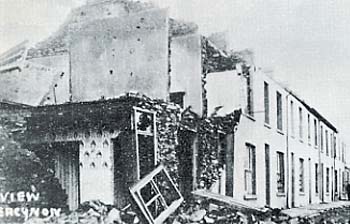
Above: major damage in Abercynon.
October 1913 went down as a dark month in the history of South Wales, as on the 14th, the terrible Senghenydd colliery disaster took place.
A less-known disaster occurred a fortnight later, when a severe thunderstorm produced one or more tornadoes with touchdowns reported in South Wales, Shropshire and Cheshire. The South Wales event was a moderately devastating tornado (T6 on the TORRO scale) which means that the winds were, at its worse, in excess of 160 mph. The track of this tornado was 11 miles (17.7 km). Three people were killed (the worst confirmed death-toll for a recent UK tornado), scores injured and damage to property was estimated at £40,000 in terms of repairs required - a considerable sum equivalent to around £2.5 million today. Add on the sorts of things people claim for with insurance these days and that damage figure would likely be tenfold or more in modern terms.
The storm responsible was first noted in South Devon at 1600 on Monday 27 October 1913 and it tracked more or less NNE, as far north as Cheshire where it passed Runcorn at approximately 2100, heading into Lancashire. The replotted synoptic charts for the 26th-28th October are reproduced below - thanks to Georg Mueller of Wetterzentrale. They give some idea of what sort of conditions were prevailing at the time.
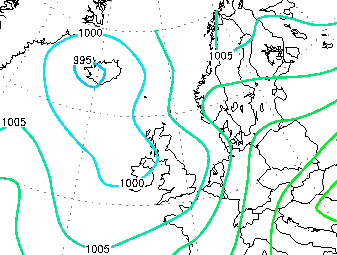
26th: Shallow low with centre over Iceland and slack area extending SE over the UK.
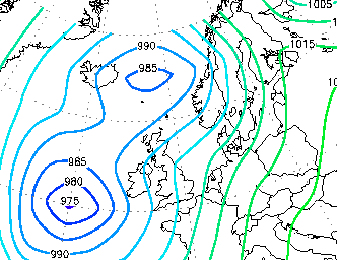
27th: Low centre remains near Iceland but to the south vigorous deepening has occurred with a new centre at 975 Mb to the west of Ireland. Strong southerly feed on low's eastern flank - this means unusually warm air being advected north from the near tropics; the air in the low itself would likely be much colder at this time of year therefore serious instability would be likely, leading to a severe thunderstorm risk.
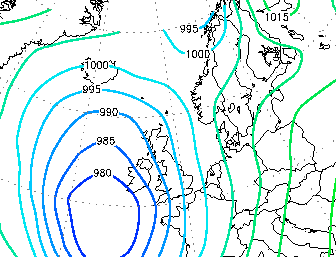
28th: Low remains to the W of the UK with southerly feed continuing.
First reports of the storm were in the Exeter area at around 1600, indicated the severity of the thunderstorm: for instance, a meteorological observer at Cullompton, Murray T. Foster, recorded:
"The day had been more or less overcast and the temperature high for the end of October, with a falling barometer. At about 3.45 p.m. heavier clouds came up from the South-west, with freshening wind and rain, until at 4 o'clock there were several flashes of lightning and thunder . . . Then at 4.05 p.m. a perfect deluge of rain fell, followed at once by a terrific hailstorm such as the oldest inhabitant never remembered having seen . . . This storm lasted over 10 minutes. A noticeable fact was that the temperature was hardly affected either on the grass or in the air."
Retired Indian Civil Service member W. A. Willock commented thus:
"I left Exeter in my motor-car on my way back to Ottery St. Mary at about 3.45 p.m. The day had been fairly fine, with a few light passing showers, in spite of a South-east wind and a low and falling barometer. It was beginning to rain a little when I started... About 3 miles from Exeter I saw a very black cloud, from which rain was falling heavily, coming up apparently from the South-east. I may have been deceived as to the direction of motion, however, owing to the motion of the car. In a couple of minutes we plunged into it, and I do not think I ever saw such rain out of the tropics. The lightning was very vivid and close, but the flashes were not more frequent than in a fairly bad thunderstorm . . . Immediately after the storm passed I could see it in the shape of a dense bluish cloud about 10 miles off to the North-west. . . The cloud only covered a very small breadth, and it had not given any rain to speak of between the place where we stopped, about 5 miles from Exeter, and Ottery."
The storm continued to move north into Somerset and crossed the Bristol Channel coast at Watchet, to make landfall on the Glamorgan side at about 1740. The tornado appears to have developed somewhere close to Efail Isaf and Llantwit Fardre, villages situated just east of Llantrisant and just north of the M4. In this area, its track was "fifty yards wide" and winds were strong enough to do considerable damage to light outdoor structures such as henhouses and hayricks. Continuing in a straight line, almost due north as seen in the map below, it had widened its track to "two hundred yards at Cilfynydd and over three hundred yards at Edwardsville".
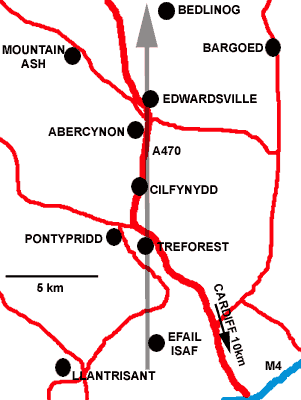 The
demarcation line between the tornado's path and the areas
on either side was highly pronounced with no wind damage
outside of the path. The tornado was accompanied by
intense lightning and torrential rain as it reached its
peak at Abercynon and Edwardsville.
The
demarcation line between the tornado's path and the areas
on either side was highly pronounced with no wind damage
outside of the path. The tornado was accompanied by
intense lightning and torrential rain as it reached its
peak at Abercynon and Edwardsville.Meteorological observers were few and far between in South Wales in 1913, but a Fellow of the Royal Meteorological Society lived at Edwardsville, Mr. B. P. Evans, who was headmaster at the local senior boys' school. His account of the incident is of classic status in UK tornado reporting:
"At 4.30 p.m. the wind, a gentle breeze, was from S. by E and by 5 p.m. was due S. At 5.15 p.m. a dead calm set in. The sky from 430p.m. was heavily mottled with dark patches of cumuli in the South, but these clouds presented straight edges in the SSE. It was a "troubled" sky.
To the South, as the twilight advanced, a dark sullen sky was noted. The cumulus form had disappeared except in the East, where a heavy mottled appearance was still observable until darkness came swiftly. During about half-an-hour of calm the atmosphere was oppressive, giving one a sense of great uneasiness, and a remark was made that rain would probably ease the tenseness.
Rain began to fall at 5.20 p.m. The first flash of lightning (red) was noted at 5.25 p.m., coming from a dark cloudbank in the South The rain ceased in about 10 minutes, and the red-coloured was followed by intensely blue lightning, flashing at frequent intervals. Very few peals of thunder were heard, these being sharp, with an absence of reverberation, and from about 5 40 p m the thunder was not evident. The blue lightning was appalling. When the flash occurred, which was most frequent, there seemed to be three or four interweaving flashes, all of a deep blue, and, what was strange, the waves of blue fire seemed to be rolling on the ground.
A few seconds before 5.50 p.m. we heard a noise resembling the hissing of an express locomotive. The sound grew rapidly in volume, at last resembling the rushing speed of many road lorries racing along. The oppressiveness that had been previously noticed increased, and the heat and air-pressure were pronounced during the rushing noise.
We endeavoured to move out of the room to the passage for greater safety, because a hurried remark was made that the engines of these supposed passing loaded steam lorries had collided before the house, and were about to burst, when the panes of our windows were broken by stones, tiles, slates, dried cement, and splintered timber. The missiles broke the Venetian blinds and struck the opposite walls. We made for the rear of the house, but all the windows were being bombarded also by small material and corrugated iron sheets.
We could distinctly hear the chimney-pots fall on the roof, and the material sliding off being dashed on the pavement and doorstep. We could see the kitchen clock from the hall passage. It had stopped at 5.51 p.m. It was not struck by any object. It is the largest clock in the house. Two smaller clocks in other rooms were not affected.
After this crash had ceased (this only lasted from 60 to 90 seconds), rain fell in torrents. The lightning set fire to the tar which had been sprayed some three weeks previously on the main Cardiff and Merthyr road, some 12 yards from our house door. A distinct smell of sulphur pervaded the air. The lightning continued fitfully and much less intense for about 5 minutes after the climax of the storm had passed, and thunder occurred during the rushing, crashing, roaring noise."
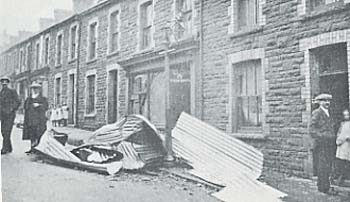 |
L: twisted corrugated iron litters the street in Cilfynydd after the tornado's passing. Such items become lethal missiles when made airborne by tornadic winds. |
The following damage account is drawn from an excellent
article by Meurig Evans in the Glamorgan Historian
journal (1975; Vol. 11 pp 212-227).
"As the storm tracked
northwards it uprooted trees and then severely damaged
the residence of Mr. Rees, the coroner at Llantwit
Fardre. A heavy wooden stable was toppled over and part
of a shed on the tennis lawn was carried a considerable
distance over a mound about twenty feet high. All the
instruments at the post office were put out of action by
the lightning.
A little further to the north the roof of a dog's kennel
was blown about one hundred yards towards the vicarage
which stood on the eastern edge of the storm track and
was itself unaffected. Passing over the hill and still
moving north very little storm damage was inflicted until
Treforest was reached, a mile away.
On rising ground to the east of the village stood the
Pontypridd Tramway and Electric Station. The iron stack
fell on to the roof and the western side of the building,
which was made of corrugated sheets, was blown outwards.
The lights in the building also went out at this time.
Both Glyntaf church and vicarage suffered severe roof
damage, coming within the 150-yard-wide track.
Subsequent investigation proved that there had been a
secondary storm track of less intensity at Treforest.
This started on high ground to the west of Treforest near
the St. Michaels Homes (above the present junior
comprehensive school). It blew down trees and fences
before crossing the river Taff and joining the main storm
at an angle of forty-five degrees.
The storm now passed over part of the grounds of the
Pontypridd Golf Club and the Meteorological Office
assistant who visited South Wales, a Mr. Billett, was
later conducted over the track of the storm at this point
by Mr. Richard Williams, the headmaster of the Cilfynydd
boys' school.
By the time the storm had reached Cilfynydd, another mile
or so, its width had increased to two hundred yards. The
linear development of the village, so typical of the
South Wales valleys, tended to result in more widespread
damage as the storm swept through the entire length from
south to north.
On the west side of the track in Howell Street stood the
local branch of the Ynysybwl Co-operative Society, which
had a roof constructed of corrugated iron sheets fixed to
steel arches. The whole roof was removed by the force of
the wind and disintegrated, some sheets landing on Graig
Evan Leyshon common, up to a mile away. One sheet was so
firmly wrapped around a telegraph pole, more than a mile
away, that it could not be removed.
The north side of Rehoboth chapel was blown inwards and
in Richard Street, where most of the village shops were
situated, goods were strewn over the road, mingling with
the debris of the roofs. On the east side of the track
formed by Wood Street considerable structural damage
occurred to the houses, and sheds and henhouses in
allotment gardens disappeared without trace. The roof of
every chapel in the village was damaged as well as that
of the school, in most cases the entire roof being
removed.
Opposite the entrance to the Albion colliery stood the
office of the local branch of the Miners' Federation, a
wooden building on heavy tram wheels. The whole structure
was swept away. The house owned by the chairman of the
Federation, Abraham Lewis, had its roof demolished and
furniture damaged. His next-door neighbour, John Jones, a
local contractor, managed to save the baby from upstairs
seconds before the bedroom was filled with collapsing
debris.
Evan Prosser, a haulier, was blown a distance of thirty
yards into the Glamorganshire canal and was fortunate not
to lose his life. Not so lucky was Thomas John Harries of
Oakland Terrace, Cilfynydd, who was found dead in a field
after being thrown nearly four hundred yards. Numerous
people suffered from cuts and bruises received from
flying objects and others had to be treated for shock.
Still moving northwards the storm followed the eastern
side of the Taff valley between Cilfynydd and Abercynon,
an area with no dwelling. On the side of the mountain,
however, stood a small building in which were stored
explosives for the Albion Colliery. The roof sailed away
with the wind. A little further north at Abercynon
thirteen houses of a terrace known as
"Fairview" had their roofs completely removed
and the partition walls of the upstairs rooms destroyed.
A number of the occupants were trapped by the debris of
collapsed buildings but were released by the police, who
arrived quickly, led by Police-Inspector Angus.
Some of the injured who did not require hospital
treatment, together with the other occupants of
demolished houses, were given shelter by neighbours.
Local councillor Bruce Jones, who was the agent for the
Dowlais collieries made available the Abercynon colliery
offices, which were turned into a temporary
lodging-house. The Western Mail reported the following
day that "thousands of people arrived on the scene
and there was no lack of willing helpers". The Royal
Oak public house and two dwellings not far from Fairview
were almost demolished by the tornado.
A short distance away stood Incline House, occupied by
Mr. and Mrs. Alfred Blake, eighty-six and seventy-four
years of age respectively. Mr. Blake was an ex-inspector
of the Taff Vale Company. The son, who was home from the
Klondike at the time described the almost complete
collapse of the house as taking place in "six or
seven seconds". Father, son and the maid received
broken legs and were buried in debris for forty-five
minutes. The mother, who was in another room at the time,
escaped with shock.
A signal-box on the Taff Vale Railway nearby was damaged
and trees close at hand were torn from the ground or
flattened while a quarter-of-a-mile further north at
Goitre Coed farm a horse and cart was hurled against the
eighteen-inch thick wall of a barn which also lost its
roof.
The storm seemed to reach its peak at
Edwardsville-blowing down most of the tombstones in the
churchyard, and wrecking the cemetery chapel. The
rooftops of the houses in Nantdda Street were extensively
damaged and all the windows of the post office were blown
in.
The English Congregational chapel was wrecked and the
pews swept against the west wall. The caretaker, Mrs
Wheeler was cleaning the chapel assisted by her two
daughters when the storm hit the building. They were
partly-buried by debris and Gertrude Wheeler one of the
daughters, was subsequently admitted to the King Edward
VII hospital, Cardiff, with serious injuries.
A large tree was uprooted at the cross roads and a second
fatality occurred at this spot. The victim was C.
Woolford, the right-back and captain of the Ton Pentre
Football Club. He and the trainer, Walter Breeze were
walking to the station on their way home and were a short
distance ahead of the rest of the team. Woolford was
dashed against a wall, fracturing his skull, while Breeze
was lucky enough to get away with a broken rib, also
having been blown against a wall.
Many trees were found with pieces of slate buried to a
depth of one-and-a-half inches in the grain. From this
point the force began to decrease, but it was still
sufficient to cause damage to roofs and trees at Bedlinog".
In addition to the above, Trevor
Harley's web pages note that
a hayrick weighing several tons was carried for a mile
and, near Pontypridd, half a ton of brick chimney was
carried several hundred yards.
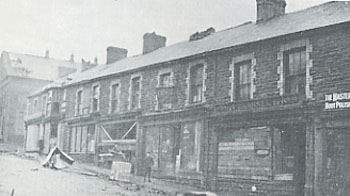 |
L: damage in Cilfynydd includes missing chimney-stacks. Note boarded up shop frontages where windows have been smashed by flying debris. |
The thunderstorm, estimated to be 7 miles in width,
continued northwards with tornadic damage occurring in
Shropshire and Cheshire, but although trees were downed
and livestock killed, no further human fatalities were
recorded. 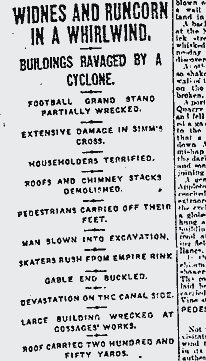 At 2030 a
tornado passing through Cheshire was heard by many people
who described it as like "the
sound of hundreds of motor cars crashing through the
trees", and was accompanied by
very vivid lightning. At Peckforton, several cows were
lifted clean over a hedge: three were killed. It may well
be fortunate that it was pitch dark by now so that the
fields were not busy with agricultural labour, or more
human casualties might have occurred.
At 2030 a
tornado passing through Cheshire was heard by many people
who described it as like "the
sound of hundreds of motor cars crashing through the
trees", and was accompanied by
very vivid lightning. At Peckforton, several cows were
lifted clean over a hedge: three were killed. It may well
be fortunate that it was pitch dark by now so that the
fields were not busy with agricultural labour, or more
human casualties might have occurred.
In Runcorn, much damage was again reported, with the
football stadium losing its roof, but some tales are
particularly remarkable - of people who were levitated
into the air by the tornado. James Shingler, by all
accounts a well-built man, recalled, "I
shall remember it if I live to be a thousand".
He was walking home from work just after nine when the
wind lifted him off his feet and dashed him into the
roadway, landing in an excavation onto a pile of paving
setts. Dazed, he managed to get himself home, coat ripped
"into ribbons".
The Weekly News coverage of events in Runcorn and Widnes
also relates that "A man named
Bollard was passing down Kent Street, where he lives,
when there was a blinding flash of lightning and he was
lifted off his feet and gently deposited again, after
being carried a considerable distance".
Such close encounters with tornadic winds are usually
less benign than this and both individuals were fortunate
not to have suffered more serious injury.
An investigation in the aftermath of the storm, and
concluded that the tornado contained winds blowing in an
anti-clockwise direction. Reports of the tornado's
duration varied from two seconds to five minutes. The Met
Office investigators concluded that "...the
storm was circular in shape; ...it advanced at thirty-six
miles an hour; ...the width in South Wales was three
hundred yards; ....the maximum duration of the storm at
any one place must have been about seventeen seconds."
As an interesting aside to the tornado, there were a
number of reports of ball lightning. Again, referring to
the Glamorgan Historian, here is an account from a train
passenger on his way to Pontypridd: "Repeated
flashes continued for four minutes and the train
travelled slower than usual, till we reached Creigiau
station, at 5.30 p.m., when I clearly observed a ball of
fire, apparently the size of my hat, flashing along with
a blinding sheet of lightning, and travelling from South
to North. 1 remarked to others about the thunderbolt, and
that great damage would be done somewhere by it."
A resident of Cilfynydd reported: "I
saw nothing out of the ordinary run of thunderstorms
until I had reached a point a little beyond Wood Street
schools. Here I observed a flash of lightning, which
seemed to assume a globular shape, sending out a long
tail-like stream of light. This was followed almost
instantly by the first crash of thunder, which was
peculiar in its sound. It reminded me forcibly of the
rattle peculiar to small artillery, with the noise
intensified." There were a
number of other witnesses to this incident.
The windspeed was not recorded, as no weather stations in
the affected area seem to have had an anemometer and
estimates of its strength are thus based on damage done.
Changes in air pressure, however, were recorded in
several places. They revealed a sudden fall followed by a
return to the previous pressure after an interval of
fifteen to thirty minutes. The Albion Steam Coal
Colliery, at Cilfynydd, was situated within a few metres
of the western edge of the tornado track and a drop in
pressure from 29.20 to 28.91 inches (988.8 to 979.0
millibars), was recorded. It was followed by an almost
immediate rise. The Met office investigators stated:
"This fall of 0.3 inch, or
1/100 of the normal atmospheric pressure of 15lbs to the
square inch, means a sudden change in the atmospheric
pressure of O.15 lb per square inch, or about 20 lbs per
square foot. Such a change of pressure, if applied
suddenly to the outside of a closed building, must
produce an effect similar to an explosion within, and it
is thus easy to understand how windows or even whole
walls are blown outwards, as at the generating station at
Treforest".
 |
L: beaten-up cottages in Cilfynydd with rooves gone and windows smashed. |
Perhaps surprisingly, only one report of a classic
funnel-cloud was received, from one Dan Williams of
Treharris, who saw "a dark
cloud extending from the sky to earth like a huge
waterspout." However, poor
visibility may have hampered good sightings - in the
eyewitness account above it seems that the approaching
tornado was heard rather than seen.
The Met Office investigation concluded with these points:
". . . a genuine tornado of the
type common enough in parts of America . . . The straight
track with clean cut lateral limits, the violent
electrical phenomena, the heavy rainfall, the roaring
noise, the sudden decrease of barometric pressure,
resulting in the blowing out of walls of buildings, as if
by explosion from within, are all features which are
common in descriptions of American tornadoes. The width
of the track, three hundred yards and the rate of
advance, 36 miles per hour, are of the same magnitude as
in American tornadoes".
All in all, this was a highly significant severe weather
event by UK standards and it is a pity that we cannot
obtain more information on the nature of the thunderstorm
that spawned such a damaging tornado.
Thanks to Terence Meaden of TORRO for
supplying further information regarding events in
Cheshire.
New! Fine Art Prints & digital images for sale-
Welsh Weather & Dyfi Valley landscapes Slide-Library - Click HERE